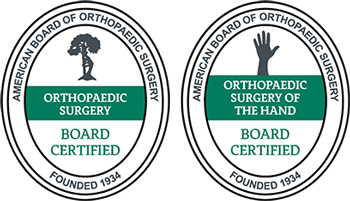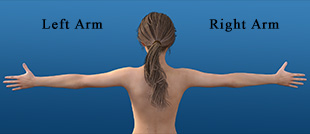Cubital Tunnel Syndrome Exercises
Cubital tunnel syndrome is a condition that arises when the funny bone, also known as the ulnar nerve, is irritated, compressed, or stretched where it crosses the sufferer’s elbow. This nerve, which supplies movement and feeling to the hand and arm, stretches from your neck all the way to the backside of your arm and straight to your hand in fingers four and five.
The cubital tunnel has an extremely thin opening. This makes the nerve very susceptible to compression or injury due to trauma or repetitive activities, which leads to the syndrome, which is also called ulnar neuropathy. Hand and Wrist Institute of Southlake, Texas offers support for those suffering from this condition throughout the Dallas, Texas area, even if your condition is severe and chronic.
Contents
Symptoms of Cubital Tunnel Syndrome

Where the funny bone crosses the elbow, the skin surface is more sensitive because the nerve is closer to it. This leads to pain that resembles that of hitting your funny bone on a hard surface, except the pain is much more intense.
Some of the symptoms of this condition include:
- Reduced or weaker grip
- Small finger base muscle loss
- Tough time straightening or bending fingers
- Trouble handling things with fingers or hands
- Finger, forearm, and arm pain and numbness
Home Treatments for Cubital Tunnel Syndrome
There are some DIY at-home treatments that may help you find a little relief from this syndrome. One essential tip is to avoid doing things that irritate the syndrome and intensify the symptoms. You can also try some of the DIY treatments below:
- Allow your elbow and arm to rest as much as you can
- Give your elbow more protection by wearing a pad over it daily
- Do not wear sports gear or clothing that squeezes or limits the movement of your elbow
- Ensure that your desk chair is leveled with the desktop when using workspaces or computers
- Wrap an ice compress in a towel or cloth and apply it to the elbow several times each day in 10-minute intervals
- Take aspirin, nonsteroid anti-inflammatory drugs (NSAIDs), or over the counter (OTC) anti-inflammatory meds
Medical Treatments for Cubital Tunnel Syndrome
There are two main cubital tunnel syndrome treatments commonly used by doctors to treat the condition:
Bracing the Arm and Elbow
Oftentimes, doctors will prescribe patients suffering from cubital tunnel syndrome with a padded elbow brace or splint. These devices should be worn at night to keep you from bending your elbow in your sleep. This has been shown to help by moderating the patterns of activity while keeping the arm and elbow in fixed positions.
According to a National Center for Biotechnology Information (NCBI) report, 21 out of 24 patients found relief in symptoms after three months of avoiding irritating activities and wearing inflexible elbow braces.
Surgery for Chronic Issues
If your symptoms continue for more than six weeks, your syndrome is more than likely considered chronic. In such cases, your physician may recommend surgery if other treatment forms do not resolve the problem.
According to doctors, surgery may help relieve symptoms of muscle weakness or loss in your hands because of the condition. Surgical treatment involves exposing the stretched, compressed, or irritated ulnar nerve and either moving it or releasing it.
After surgery, you may find that it takes months to make a full recovery. And in most cases, physical therapy is required. Even after the operation is complete, patients with severe cases may still have symptoms. However, according to Merck Manuals, around 85 percent of these cases respond positively to cubital tunnel surgery.
Cubital Tunnel Syndrome Exercises for Pain Relief
Many experts agree that there are some exercises that may help relieve the pain and other symptoms caused by cubital tunnel syndrome. The idea is to partake in movements that help the ulnar nerve gently glide through the Guyon’s and cubital canals.
What is the cubital canal? It is the tiny channel that houses the ulnar nerve as it runs through it along the inner side of your elbow. The Guyon’s canal acts as the passageway for the ulnar nerve to reach the wrist and down into the hand.
Here are some exercises that help with the nerve gliding process to help relieve your cubital tunnel syndrome symptoms:
Exercise 1
- Extend your arm out in front of you with your elbow completely straight and your palm facing the sky, without causing too much discomfort.
- Gently and slowly curl your fingers into a fist, then gently and slowly turn them downward.
- Gently and slowly bend your elbow, then slowly extend your arms out again.
Exercise 2
- Extend your arm out in front of you with your elbow completely straight and your palm facing the sky, without causing too much discomfort.
- Gently and slowly bend your elbow toward your face while delicately twisting your wrist so your palm is facing your body.
- If the two steps above cause you too much pain or discomfort, gently bend your elbow while keeping your wrist bent, hold it for as long as possible and release it slowly.
Exercise 3
- Lie down, sit up and stand while stretching the arm out so it is straight alongside your body while clenching your fist slightly.
- Gently and slowly bend your elbow, raising your fists up toward your chest, hold for a moment and slowly release.
Exercise 4
- Stand in place, bending your elbow so that your forearm is in a position that’s parallel to your body.
- Gently and slowly twist your palm so that it is facing the sky, then twist it slowly until it is facing the floor.
Contact the Hand and Wrist Institute Today!
Complete these cubital tunnel syndrome exercises and stretches 2-5 times per day. If this doesn’t relieve the symptoms, contact The Hand and Wrist Institute of Dallas, Texas to discuss more treatment options.
Give us a call at (817) 382-6789 to schedule a consultation with our hand and wrist specialists. Or click here to schedule an appointment online now.

























